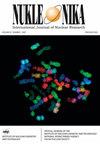黑山大学预科教育大楼一楼的氡
IF 0.3
4区 物理与天体物理
Q4 CHEMISTRY, INORGANIC & NUCLEAR
引用次数: 2
摘要
摘要最近在黑山所有大学前教育的建筑中进行了一次全国氡调查。2016/2017学年,在468栋建筑的2855个底层房间中,使用无源探测器(Radosys,RSFV型)测量了氡(222Rn)。在213栋建筑的728个房间中发现了超过300 Bq/m3水平的9个月平均氡活动浓度,而在47栋建筑的111个房间中,氡活动浓度超过1000 Bq/m3。教育建筑中的氡浓度,在一栋建筑的所有底层房间取样的平均值范围为16 Bq/m3至2810 Bq/m3,算术平均值(AM)=275 Bq/m3。它们遵循对数正态分布,几何平均值(GM)=174Bq/m3,几何标准差(GSD)=2.58。一楼有135栋建筑的室内氡平均浓度超过300 Bq/m3,18栋建筑的氡平均浓度高于1000 Bq/m3。采用单变量(UVA)和多变量(MVA)方法分析了九个因素(气候、城市/农村地区、建筑年代、层数、建筑材料、地下室、地基板、窗框和供暖)对建筑物中氡浓度的影响。单变量分析揭示了四个因素:建筑物的年龄、地下室、建筑材料和窗框与建筑物底层氡浓度的显著关系,而多变量分析增加了城市/农村地区和层数的因素,但排除了建筑材料作为显著影响氡浓度的因素。本文章由计算机程序翻译,如有差异,请以英文原文为准。
Radon on the ground floor in the buildings of pre-university education in Montenegro
Abstract A national radon survey was performed recently in all buildings of pre-university education in Montenegro. During the school year 2016/2017, radon (222Rn) was measured with passive detectors (Radosys, RSFV type) in 2855 ground-floor rooms of 468 buildings. The average 9-month radon activity concentrations above the level of 300 Bq/m3 were found in 728 rooms, which belong to 213 buildings, while in 111 rooms, belonging to 47 buildings, they were above 1000 Bq/m3. Radon concentrations in the educational buildings, averaged over all sampled ground-floor rooms in a building, range from 16 Bq/m3 to 2810 Bq/m3, with arithmetic mean (AM) = 275 Bq/m3. They follow a log-normal distribution with geometric mean (GM) = 174 Bq/m3 and geometric standard deviation (GSD) = 2.58. There are 135 buildings with average indoor radon concentrations on the ground floor above 300 Bq/m3 and 18 buildings where they are above 1000 Bq/m3. The influence of the nine factors (climate, urban/rural area, age of building, number of stories, building materials, basement, foundation slab, window frames, and heating) on radon concentrations in the buildings was analysed by univariate (UVA) and multivariate (MVA) methods. The univariate analysis revealed the significant relationship of the four factors: age of buildings, basement, building materials, and window frames with radon concentrations on the ground floor in the buildings, while multivariate analysis added to those factors urban/rural area and number of stories, but excluded building materials as a factor influencing significantly radon concentrations.
求助全文
通过发布文献求助,成功后即可免费获取论文全文。
去求助
来源期刊

Nukleonika
物理-无机化学与核化学
CiteScore
2.00
自引率
0.00%
发文量
5
审稿时长
4-8 weeks
期刊介绍:
"Nukleonika" is an international peer-reviewed, scientific journal publishing original top quality papers on fundamental, experimental, applied and theoretical aspects of nuclear sciences.
The fields of research include:
radiochemistry, radiation measurements, application of radionuclides in various branches of science and technology, chemistry of f-block elements, radiation chemistry, radiation physics, activation analysis, nuclear medicine, radiobiology, radiation safety, nuclear industrial electronics, environmental protection, radioactive wastes, nuclear technologies in material and process engineering, radioisotope diagnostic methods of engineering objects, nuclear physics, nuclear reactors and nuclear power, reactor physics, nuclear safety, fuel cycle, reactor calculations, nuclear chemical engineering, nuclear fusion, plasma physics etc.
 求助内容:
求助内容: 应助结果提醒方式:
应助结果提醒方式:


